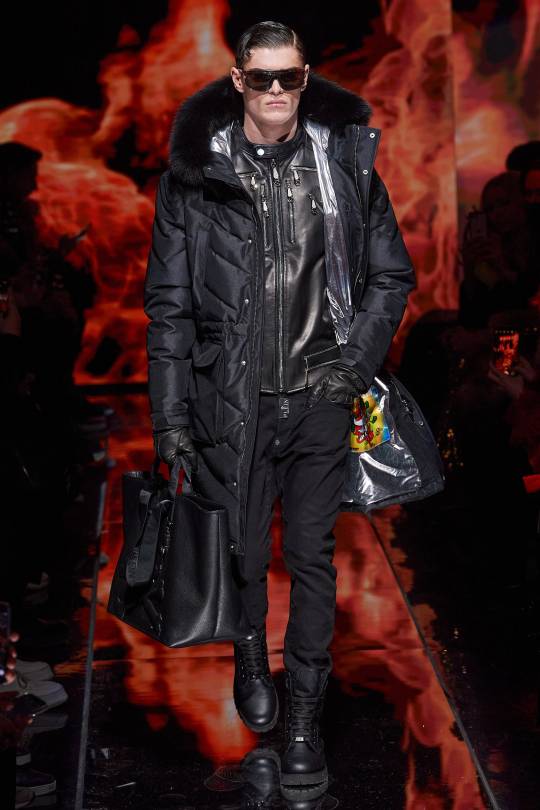#mattia giovannoni
Photo

Mattia Giovannoni for Philipp Plein, Spring 2022
10 notes
·
View notes
Text
Summary, Week 12
Computers have, in one form or another, been around for a very long time. Mechanisms like the Antikythera mechanism, or the Curta calculator show that our ability to use devices to extend our mathematical abilities and understand, interpret, and record complicated realities has been with us for centuries. During World War 2, mechanical computing devices took huge steps forward to help break codes. The Harvard Mark 1, developed at this time, was in non-stop operation from 1944 through 1959. Vacuum tubes replaced gears, and then transistors replaced vacuum tubes, and then circuit boards came along to refine the technology into what we now recognize as computing.
Electronics created problems for designers, as time-honored thinking about the relationship between form and function no longer applied. With function being dematerialized, designers struggled to find new considerations for form language like emotion and narrative and even humor. "Product Semantics" is the fancy term we use to talk about this effort to infuse design with layers of narrative in the absence of mechanical constraints. The use of electronics was easy to find in toys in the late 1970's. As circuit boards transformed other objects, designers began to realize the importance of operational sequences, and new kinds of interfaces that could explain the mysterious operations of a screen-and-button object.
Because design began to be more focused on external form, designers became known for their personal, sculptural form sensibilities. From the Memphis movement in the early 1980s to the Alessi Coffee and Tea Piazza series to Philippe Starck in the 1990s to Marc Newson and Ross Lovegrove today, the era of the Celebrity Designer was born.
Computers challenged designers' abilities to house electronics in designed objects with some sort of logic. They also allowed a new approach to design with the introduction of CAD and CAM systems. Early CAD setups were expensive and limited, and as a result useful in only a few environments. As personal computers became more sophisticated in the 1980s, more professions began to develop computer assisted design tools. When Hollywood began creating 3D animations, putting skins over the wire form drawings, and creating controlled lighting effects, CAD began to resemble what we still use today for design. Because CAD software is inherently math-based, designers were (and still are to a lesser extent) forced to compromise their form language and arrive at a frequently clumsy hybrid of personal expression and geometry.
In a fevered attempt to end with an example of design gone RIGHT, I crashed the class into Smart Design and OXO. Sam Farber spent a lifetime in kitchenware design (Farberware, Copco). His last company was OXO, founded to distribute ergonomic kitchen tools designed in partnership with Smart Design. This was, and continues to be, a happy and successful combination of everything we looked at this semester. Now it is your turn…
Designers and other useful names Included:
Archimedes
Joseph Marie Jacquard
Curt Herzstark
Hartmut Esslinger/frogdesign
Susan Kare
Jonathan Ives
Leon Theremin
Isamu Noguchi
Mario Bellini
Dietrich Lubs
Nobutoshi Kihara
Martin Cooper
Ettore Sottsass
Graham Hinde
Klaus Krippendorff
Lisa Krohn
Tucker Viemeister
Leslie Fontana
Ideal Group
Donald Booty Jr.
Technology Design
Michael Graves
Ronald Lytel
Donald Booty Jr
Philippe Starck
Luigi Colani
Ivan Sutherland
Patrick Hanratty
Anna Castelli Ferrieiri
James O'Halloran/Kevin Foley
Peter Schneider
Jürgen Greubel
Marc Newson
Karim Rashid
Guido Ventorini
Alessandro Mendini
Mattia di Rosa
Stefano Giovannoni
Ross Lovegrove
Konstantin Grcic
Marco Zanini
Masanori Umeda
Michele De Lucchi
Martine Bedine
Giovanni Alessi
Alberto Alessi
Carlo Alessi
Aldo Rossi
Kazumasa Yamashita
Charles Jencks
Oscar Tusquets
Stanley Tigerman
Richard Meier
Hans Hollein
Robert Venturi
Yves Béhar
Naoto Fukasawa
Sam Farber
Michael Lax
Smart Design (Tucker Viemeister)
There were many more:
Jack Kilby, Jerry Merryman, James Van Tassel
Howard J. Morrison
Ralph Baer
Rüdiger Bachorski
Robert Nakata
Paul Montgomery
William Wurz
Till Winkler
Duy Phong Vu
Björn Kling
Steve Vordenberg, Allen Zadeh, Arsenio Garcia
5 notes
·
View notes
Photo

I’m loving the direction of mens fashion. The bold colors and mixed patterns are so fun snd whimsical 😍 * Mattia Giovannoni for Philipp Plein, Spring 2022 Menswear #mensfashionpost #colormyworld #fashionstyle #fashiondesigner #fashioninspiration #desighnerwear #philippplein (at Catalina Foothills, Arizona) https://www.instagram.com/p/CkTY-X_r3wZbZ7ytaoV-ekpD2MMpZWBM6acn1g0/?igshid=NGJjMDIxMWI=
#mensfashionpost#colormyworld#fashionstyle#fashiondesigner#fashioninspiration#desighnerwear#philippplein
0 notes
Text
Tomita Kazuhiko
Tomita Kazuhiko. Diseñador industrial y de producto.
Tomita Kazuhiko (1965, Nagasaki, Japón) se describe a sí mismo como un nómada errante entre el Este y el Oeste, y su trayectoria profesional y biográfica no hace más que confirmar esta teoría.
Como diseñador es capaz de construir nuevas marcas o de darles un nuevo giro, al aplicar su experiencia creativa en varios campos, desde el diseño gráfico hasta la arquitectura.
Tomita Kazuhiko estudió diseño industrial en la Universidad de Chiba en Japón (1989).
Posteriormente, en la década de 1990, gracias a una beca de Cassina & British Council, estudió diseño de muebles en el Royal College of Arts de Londres, donde se graduó en 1992.
Éste mismo año (1992) se mudó a la ciudad que es la meca del diseño industrial: Milán.
En 1993 diseñó la línea “Stars” de productos cerámicos en colaboración con Alessandro Mendini y Ettore Sottsass.
También en 1993 fundó el Studio 2.5-Dimensional Design (Milán) -que después se convertiría en Tomitadesign– empezando a presentar sus colecciones en ferias internacionales.
En el año 2000, se convirtió en director de Arte de la compañía COVO, y en este contexto, diseñó también la COVO Shop en la ciudad de Roma.
COVO, una marca con un ADN completamente italiano y raíces internacionales, combina elegancia con simplicidad, tradición y contemporaneidad, y clasicismo con diseño vanguardista.
En 2001 creó la colección de artículos de mesa “Rim” para Rörstrand, empresa de porcelana en Kungsholmen (Estocolmo, Suecia), junto con Vico Magistretti.<
Tomita Kazuhiko fue nombrado director de Arte de NUSSHA París en 2004, y desde entonces ha trabajado con varios fabricantes más, incluida por ejemplo, la empresa italiana Moroso.
Las creaciones de Tomita Kazuhiko son lúdicas, pero a la vez prácticas.
Con una mirada cuidadosa y sensible que combina armoniosamente forma y contenido promueve, sin sacrificar nada a la funcionalidad, la investigación y la experimentación que va desde el uso hábil de los materiales hasta la selección previsora de productores internacionales.
Su universo se encuadra dentro del arte y del estilo de vida tradicional japonés a la vez que convive con el concepto europeo de lo moderno. Sus ideas asumen el mismo objetivo, hacer artículos destinados a un uso global y prolongado que dure toda la vida.
Un factor de enlace entre todas sus creaciones es la simplicidad, pues para él éste es un factor muy importante, pero no la simplicidad llevada al minimalismo entendido como lo hacía la Bauhaus.
Para Tomita Kazuhiko la reducción a lo que es importante y esencial es una característica del shintoismo japonés, donde según su teoría los objetos inanimados también contienen energía espiritual.
Así por ejemplo, la colección de mesas de sobremesa”UkiYo” (2006-2007) para Moroso, realizadas en resina de poliéster co-moldeada, están decoradas con los patrones utilizados en los kimonos tradicionales e inspirados en Ukiyo, un movimiento cultural japonés del siglo XVIII.
Relacionado con el realismo sintoísta, que establece que nada puede permanecer sin cambios durante mucho tiempo, la filosofía de este movimiento (Ukiyo) vive cada momento al máximo como una forma, curiosamente, de alcanzar la vida eterna.
Desde esta perspectiva, la floración se convierte en el período anual más alegre y radiante, donde se extiende por todas partes la máxima cantidad de energía. Sin embargo, nadie puede decir si la flor recién florecida seguirá viva un momento después.
Las tapas o sobres de estas mesitas -con finísimas patas de acero tubular acabado en polvo RAL 3003 rojo brillante- se pueden invertir y utilizar como bandejas.
Su trabajo se ha exhibido a nivel mundial, en ciudades como Tokio (exposición individual “2.5-Dimensional Design“, Ozone Gallery, 1999); en Jerusalén (“FUSION: Arquitectura + Diseño en Japón“, 2002, Museo de Israel); Nueva York (Exposición “COVO”, 2002, galería Totem SOHO) o en Milán (“RE-FUSION”, 2003).
También sus productos han entrado en los museos para quedarse, como los productos que diseñó para la marca Essential, que se han integrado en la colección permanente del Museo de Arte Moderno de Nueva York.
Tomita Kazuhiko es profesor visitante en Diseño Industrial en la Universidad de Roma.
Y ha ganado numerosos premios internacionales a lo largo de su carrera, como por ejemplo el primer premio en el concurso “El futuro arquitectónico del acero inoxidable” (Londres, 1991) por Sir Noman Foster.
El Marchette Award Gold, RCA, (Londres, 1993); Distinción G-mark / Good Design Award (1998), Departamento de pequeñas y medianas empresas, JIDPO (Tokio), y The International Design Yearbook (1998 y 2002), Londres.
Tomita Kazuhiko (pág. web).
Tomita Kazuhiko y mesa de sobremesa”UkiYo” (2006-2007) para Moroso.
TodosABCDEFGHIJKLMNOPQRSTUVWXYZ
A
Achille Castiglioni
Adolf Loos
Alessandro Mendini
Alfredo Häberli
Alvar Aalto
Andrea Branzi
Andrée Putman
Andreu Carulla
Andy Martin
Antonio Citterio
Arend Groosman
Arik Levy
Arne Jacobsen
Atelier Oï
Atelier Van Lieshout
Autoban
B
BarberOsgerby
Benjamin Graindorge
Benjamin Hubert
Bertjan Pot
Boca do Lobo
C
Carlo Alessi
Carlo Mollino
Carlos Tíscar
Charles Rennie Mackintosh
Charles y Ray Eames
Claesson Koivisto Rune
Claudio Colucci
Curro Claret
D
David Adjaye
Dieter Rams
DimoreStudio
Doriana y Massimiliano Fuksas
Doshi Levien
E
Ed Annink
Edward van Vliet
Eero Aarnio
Eero Saarinen
Eileen Gray
Elena Manferdini
Elisabeth Garouste
Enrico Franzolini
Enzo Mari
Ettore Sottsass
F
Fabio Novembre
Färg & Blanche
Federica Capitani
Fernando Mastrangelo
Filippo Mambretti
Finn Juhl
Formafantasma
Francesco Rota
François Bauchet
Frank Gehry
Frank Lloyd Wright
Fredrikson Stallard
G
Gabriella Crespi
Gae Aulenti
Gaetano Pesce
Geoffrey Harcourt
George Nelson
George Sowden
Gerrit Rietveld
Gio Ponti
Goula Figuera
Greg Lynn
H
Hans J. Wegner
Héctor Serrano
Hella Jongerius
Hermanos Campana
Hervé Van der Straeten
I
Ico Parisi
India Mahdavi
Inga Sempé
J
Jaime Hayón
Jasper Morrison
Jean Prouvé
Jean Royère
Jean-Louis Deniot
Jean-Marie Massaud
Jean-Michel Frank
Jeffrey Bernett
Jens Risom
Joaquim Tenreiro
Joe Colombo
Johan Lindstén
Jonathan Adler
Joost Van Bleiswijk
Jörg Schellmann
Joris Laarman
Josef Hoffmann
Jurgen Bey
K
Kaare Klint
Kaj Franck
Karim Rashid
Kelly Wearstler
Kenya Hara
Kiki Van Eijk
Konstantin Grcic
L
Le Corbusier
Lex Pott
Lievore Altherr
Lindsey Adelman
Lucas Muñoz Muñoz
Ludovica y Roberto Palomba
Lukas Peet
M
Maarten Baas
Maarten Van Severen
Marc Newson
Marc Thorpe
Marcel Breuer
Marcel Wanders
Marco Acerbis
Marianne Brandt
Marie Christophe
Mario Bellini
Mario Ruíz
Martin Szekely
Martino Gamper
Massimo Iosa Ghini
Matali Crasset
Matteo Thun
Mattia Bonetti
Max Lamb
Michael Anastassiades.
Michele de Lucchi
Mies van Der Rohe
Miguel Milá
N
Nacho Carbonell
Nadadora
Naoto Fukasawa
Neil Poulton
Nendo
Nigel Coates
Nika Zupanc
Noé Duchaufour-Lawrance
O
Odosdesign
Oeuffice
Olivier Mourgue
Ora Ïto
OS and OOS
P
Paola Navone
Paolo Lomazzi
Patricia Urquiola
Patrick Jouin
Patrick Naggar
Patrick Norguet
Pedro Friedeberg
Peter Ghyczy
Peter Marino
Philip Michael Wolfson
Philippe Starck
Piero Fornasetti
Piero Lissoni
Pierre Charpin
Pierre Paulin
Piet Hein Eek
Poul Kjaerholm
Q
Quentin de Coster
R
Ricardo Fasanello
Richard Hutten
Richard Sapper
Rick Owens
Rodolfo Bonetto
Rodolfo Dordoni
Ron Arad
Ron Gilad
Ronan & Erwan Bouroullec
Ross Lovegrove
S
Sacha Lakic
SANAA
Satyendra Pakhalé
Scholten & Baijings
Serge Mouille
Sérgio Rodrigues
Seung-Yong Song
Shiro Kuramata
Simone Simonelli
Snarkitecture
Sori Yanagi
Sou Fujimoto
Stefan Diez
Stefano Giovannoni
Studio Job
Studio Kaksikko
T
Tapio Wirkkala
Tejo Remy
Thomas Sandell
Tobia Scarpa
Tokujin Yoshioka
Tom Dixon
Tomita Kazuhiko
Toni Grilo
Tord Boontje
U
Ueli y Susi Berger
UUfie
V
Verner Panton
Vico Magistretti
Vincent Van Duysen
Vincenzo de Cotiis
Vladimir Kagan
Von Pelt
W
Warren Platner
William Plunkett
William Sawaya
X
Xavier Lust
Xavier Mañosa
Y
Yrjo Kukkapuro
Yves Béhar
Z
Zaha Hadid
Zanuso
from https://decorador.online/disenadores-destacados/tomita-kazuhiko/
1 note
·
View note
Text

Mattia Giovannoni at Philipp Plein, Fall 2022
4 notes
·
View notes













